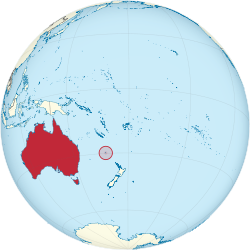Norfolk Island | |
|---|---|
| Territory of Norfolk Island Teratri a' Norf'k Ailen (Pitcairn-Norfolk)[1] | |
| Motto: "Inasmuch"[2] | |
| Anthem: "Advance Australia Fair" | |
| Territorial anthems: "Come Ye Blessed" "God Save the King" | |
 Location of Norfolk Island | |
| Sovereign state | Australia |
| Separation from Tasmania | 1 November 1856 |
| Transfer to Australia | 1 July 1914 |
| Named for | Mary Howard, Duchess of Norfolk |
| Capital | Kingston 29°03′22″S 167°57′40″E / 29.056°S 167.961°E |
| Largest town | Burnt Pine |
| Official languages | |
| Ethnic groups (2016) | |
| Religion |
|
| Demonym(s) | Norfolk Islander[6] |
| Government | Directly administered dependency |
• Monarch | Charles III |
| Sam Mostyn | |
| George Plant | |
| Parliament of Australia | |
• Senate | represented by ACT senators (since 2016) |
| included in the Division of Bean (since 2018) | |
| Area | |
• Total | 34.6 km2 (13.4 sq mi) |
• Water (%) | negligible |
| Highest elevation | 319 m (1,047 ft) |
| Population | |
• 2021 census | 2,188[7] (not ranked) |
• Density | 61.9/km2 (160.3/sq mi) (not ranked) |
| GDP (nominal) | 2016 estimate |
• Total | US$60,209,320[8] |
| Currency | Australian dollar (AU$) (AUD) |
| Time zone | UTC+11:00 (NFT) |
• Summer (DST) | UTC+12:00 (NFDT) |
| Driving side | left |
| Calling code | +672 |
| Postcode | NSW 2899 |
| ISO 3166 code | NF |
| Internet TLD | .nf |
Norfolk Island (/ˈnɔːrfək/ NOR-fək, locally /ˈnɔːrfoʊk/ NOR-fohk;[9] Norfuk: Norf'k Ailen[10]) is an external territory of Australia located in the Pacific Ocean between New Zealand and New Caledonia, approximately 1,412 kilometres (877 mi) east of Australia's Evans Head and about 900 kilometres (560 mi) from Lord Howe Island. Together with the neighbouring Phillip Island and Nepean Island, the three islands collectively form the Territory of Norfolk Island.[11] At the 2021 census, it had 2,188 inhabitants living on a total land area of about 35 km2 (14 sq mi).[7] Its capital and administrative seat is Kingston, while its main town and largest settlement is Burnt Pine.

East Polynesians were the first to settle Norfolk Island, but they had already departed when Great Britain settled it as part of its 1788 colonisation of Australia. The island served as a convict penal settlement from 6 March 1788 until 5 May 1855, except for an 11-year hiatus between 15 February 1814 and 6 June 1825,[12][13] when it lay abandoned. On 8 June 1856, permanent civilian residence on the island began when descendants of the Bounty mutineers were relocated from Pitcairn Island. In 1914, the UK handed Norfolk Island over to Australia to administer as an external territory.[14]
Native to the island, the evergreen Norfolk Island pine is a symbol of the island and is pictured on its flag. The pine is a key export for Norfolk Island, being a popular ornamental tree in Australia (where two related species grow), and also worldwide.
- ^ Buffett, Alice, An Encyclopædia of the Norfolk Island Language, 1999
- ^ "The Legislative Assembly of Norfolk Island". Archived from the original on 18 December 2014. Retrieved 18 October 2014.
- ^ "Norfolk Island Language (Norf'k) Act 2004". Archived from the original on 25 July 2008. Retrieved 6 February 2018.
- ^ 2016 Census QuickStats Archived 2 October 2017 at the Wayback Machine – Norfolk Island – Ancestry, top responses
- ^ "2021 Norfolk Island, Census All persons QuickStats | Australian Bureau of Statistics". Archived from the original on 1 November 2022. Retrieved 4 March 2023.
- ^ "Norfolk Island". The World Factbook. Central Intelligence Agency. 16 October 2012. Archived from the original on 18 January 2021. Retrieved 27 October 2012.
- ^ a b Australian Bureau of Statistics (28 June 2022). "Norfolk Island (Suburbs and Localities)". 2021 Census QuickStats. Retrieved 7 July 2022.
- ^ KPMG (2019). Monitoring the Norfolk Island Economy (PDF). Norfolk Islands: Department of Infrastructure, Transport, Cities and Regional Development. p. 4. Archived (PDF) from the original on 9 August 2021. Retrieved 9 August 2021.
- ^ Wells, John C. (2008). Longman Pronunciation Dictionary (3rd ed.). Longman. ISBN 978-1-4058-8118-0.
- ^ "NI Arrival Card" (PDF). Archived from the original (PDF) on 13 November 2011. Retrieved 28 March 2013.
- ^ "Norfolk Island Act 1979". Federal Register of Legislation. 23 May 2018. Archived from the original on 16 July 2019. Retrieved 17 July 2019. Schedule 1.
- ^ "History and Culture on Norfolk Island". Archived from the original on 12 July 2012. Retrieved 15 September 2016.
- ^ "Norfolk Island: A Short History". Archived from the original on 7 March 2016.
- ^ Cite error: The named reference
Roberts-Wraywas invoked but never defined (see the help page).

